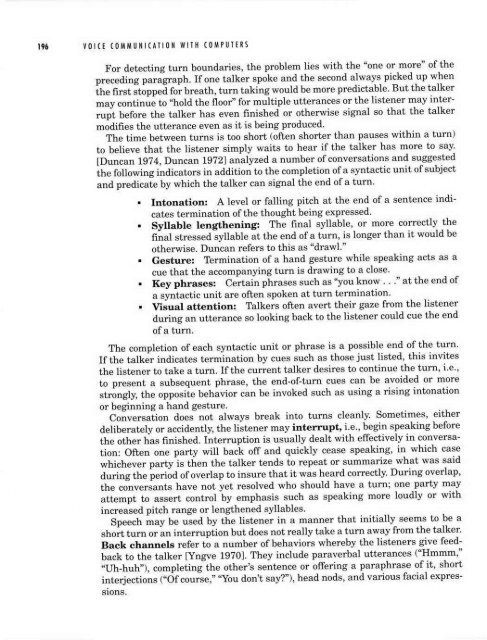MAS.632 Conversational Computer Systems - MIT OpenCourseWare
MAS.632 Conversational Computer Systems - MIT OpenCourseWare
MAS.632 Conversational Computer Systems - MIT OpenCourseWare
Create successful ePaper yourself
Turn your PDF publications into a flip-book with our unique Google optimized e-Paper software.
196 VOICE COMMUNICATION WITH COMPUTERS<br />
For detecting turn boundaries, the problem lies with the "one or more" of the<br />
preceding paragraph. If one talker spoke and the second always picked up when<br />
the first stopped for breath, turn taking would be more predictable. But the talker<br />
may continue to "hold the floor" for multiple utterances or the listener may interrupt<br />
before the talker has even finished or otherwise signal so that the talker<br />
modifies the utterance even as it is being produced.<br />
The time between turns is too short (often shorter than pauses within a turn)<br />
to believe that the listener simply waits to hear if the talker has more to say.<br />
[Duncan 1974, Duncan 1972] analyzed a number of conversations and suggested<br />
the following indicators in addition to the completion of a syntactic unit of subject<br />
and predicate by which the talker can signal the end of a turn.<br />
* Intonation: A level or falling pitch at the end of a sentence indicates<br />
termination of the thought being expressed.<br />
* Syllable lengthening: The final syllable, or more correctly the<br />
final stressed syllable at the end of a turn, is longer than it would be<br />
otherwise. Duncan refers to this as "drawl."<br />
* Gesture: Termination of a hand gesture while speaking acts as a<br />
cue that the accompanying turn is drawing to a close.<br />
* Key phrases: Certain phrases such as "you know..." at the end of<br />
a syntactic unit are often spoken at turn termination.<br />
* Visual attention: Talkers often avert their gaze from the listener<br />
during an utterance so looking back to the listener could cue the end<br />
of a turn.<br />
The completion of each syntactic unit or phrase is a possible end of the turn.<br />
If the talker indicates termination by cues such as those just listed, this invites<br />
the listener to take a turn. If the current talker desires to continue the turn, i.e.,<br />
to present a subsequent phrase, the end-of-turn cues can be avoided or more<br />
strongly, the opposite behavior can be invoked such as using a rising intonation<br />
or beginning a hand gesture.<br />
Conversation does not always break into turns cleanly Sometimes, either<br />
deliberately or accidently, the listener may interrupt, i.e., begin speaking before<br />
the other has finished. Interruption is usually dealt with effectively in conversation:<br />
Often one party will back off and quickly cease speaking, in which case<br />
whichever party is then the talker tends to repeat or summarize what was said<br />
during the period of overlap to insure that it was heard correctly. During overlap,<br />
the conversants have not yet resolved who should have a turn; one party may<br />
attempt to assert control by emphasis such as speaking more loudly or with<br />
increased pitch range or lengthened syllables.<br />
Speech may be used by the listener in a manner that initially seems to be a<br />
short turn or an interruption but does not really take a turn away from the talker.<br />
Back channels refer to a number of behaviors whereby the listeners give feedback<br />
to the talker [Yngve 1970]. They include paraverbal utterances ("Hmmm,"<br />
"Uh-huh"), completing the other's sentence or offering a paraphrase of it, short<br />
interjections ("Of course," "You don't say?"), head nods, and various facial expressions.

















